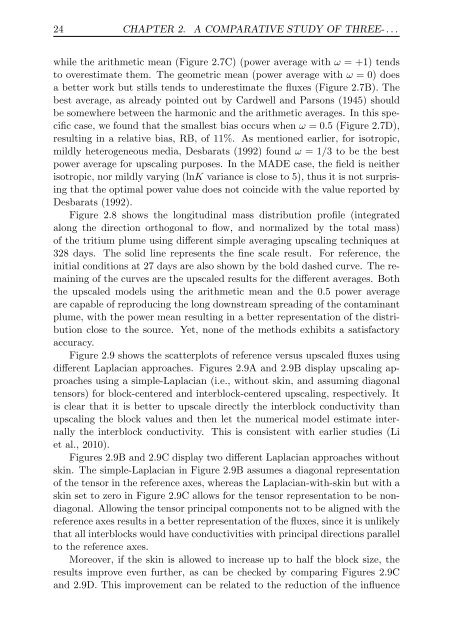Upscaling and Inverse Modeling of Groundwater Flow and Mass ...
Upscaling and Inverse Modeling of Groundwater Flow and Mass ...
Upscaling and Inverse Modeling of Groundwater Flow and Mass ...
You also want an ePaper? Increase the reach of your titles
YUMPU automatically turns print PDFs into web optimized ePapers that Google loves.
24 CHAPTER 2. A COMPARATIVE STUDY OF THREE- . . .<br />
while the arithmetic mean (Figure 2.7C) (power average with ω = +1) tends<br />
to overestimate them. The geometric mean (power average with ω = 0) does<br />
a better work but stills tends to underestimate the fluxes (Figure 2.7B). The<br />
best average, as already pointed out by Cardwell <strong>and</strong> Parsons (1945) should<br />
be somewhere between the harmonic <strong>and</strong> the arithmetic averages. In this specific<br />
case, we found that the smallest bias occurs when ω = 0.5 (Figure 2.7D),<br />
resulting in a relative bias, RB, <strong>of</strong> 11%. As mentioned earlier, for isotropic,<br />
mildly heterogeneous media, Desbarats (1992) found ω = 1/3 to be the best<br />
power average for upscaling purposes. In the MADE case, the field is neither<br />
isotropic, nor mildly varying (lnK variance is close to 5), thus it is not surprising<br />
that the optimal power value does not coincide with the value reported by<br />
Desbarats (1992).<br />
Figure 2.8 shows the longitudinal mass distribution pr<strong>of</strong>ile (integrated<br />
along the direction orthogonal to flow, <strong>and</strong> normalized by the total mass)<br />
<strong>of</strong> the tritium plume using different simple averaging upscaling techniques at<br />
328 days. The solid line represents the fine scale result. For reference, the<br />
initial conditions at 27 days are also shown by the bold dashed curve. The remaining<br />
<strong>of</strong> the curves are the upscaled results for the different averages. Both<br />
the upscaled models using the arithmetic mean <strong>and</strong> the 0.5 power average<br />
are capable <strong>of</strong> reproducing the long downstream spreading <strong>of</strong> the contaminant<br />
plume, with the power mean resulting in a better representation <strong>of</strong> the distribution<br />
close to the source. Yet, none <strong>of</strong> the methods exhibits a satisfactory<br />
accuracy.<br />
Figure 2.9 shows the scatterplots <strong>of</strong> reference versus upscaled fluxes using<br />
different Laplacian approaches. Figures 2.9A <strong>and</strong> 2.9B display upscaling approaches<br />
using a simple-Laplacian (i.e., without skin, <strong>and</strong> assuming diagonal<br />
tensors) for block-centered <strong>and</strong> interblock-centered upscaling, respectively. It<br />
is clear that it is better to upscale directly the interblock conductivity than<br />
upscaling the block values <strong>and</strong> then let the numerical model estimate internally<br />
the interblock conductivity. This is consistent with earlier studies (Li<br />
et al., 2010).<br />
Figures 2.9B <strong>and</strong> 2.9C display two different Laplacian approaches without<br />
skin. The simple-Laplacian in Figure 2.9B assumes a diagonal representation<br />
<strong>of</strong> the tensor in the reference axes, whereas the Laplacian-with-skin but with a<br />
skin set to zero in Figure 2.9C allows for the tensor representation to be nondiagonal.<br />
Allowing the tensor principal components not to be aligned with the<br />
reference axes results in a better representation <strong>of</strong> the fluxes, since it is unlikely<br />
that all interblocks would have conductivities with principal directions parallel<br />
to the reference axes.<br />
Moreover, if the skin is allowed to increase up to half the block size, the<br />
results improve even further, as can be checked by comparing Figures 2.9C<br />
<strong>and</strong> 2.9D. This improvement can be related to the reduction <strong>of</strong> the influence


